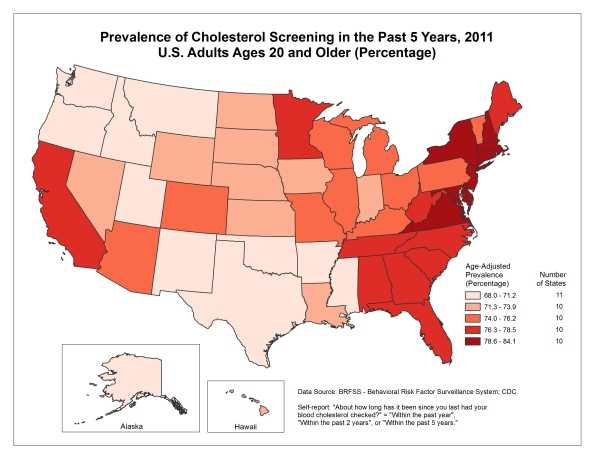Cholesterol Fact Sheet

Source: CDC, Behavioral Risk Factor Surveillance System.
Cholesterol Facts
- Having high blood cholesterol puts you at risk of heart disease, the leading cause of death in the United States.
- People with high cholesterol have about twice the risk of heart disease as people with lower levels.
- Cholesterol is a waxy, fat-like substance. Your body needs some cholesterol, but it can build up on the walls of your arteries and lead to heart disease and stroke when you have too much in your blood.
- 71 million American adults (33.5%) have high low-density lipoprotein (LDL), or “bad,” cholesterol.1
- Only 1 out of every 3 adults with high LDL cholesterol has the condition under control.1
- Less than half of adults with high LDL cholesterol get treatment.1
- Lowering your cholesterol can reduce your risk of having a heart attack, needing heart bypass surgery or angioplasty, and dying of heart disease.
- Exercising, eating a healthy diet, and not smoking will help you prevent high cholesterol and reduce your levels.
- High cholesterol has no symptoms, so many people don’t know that their cholesterol is too high. Your doctor can do a simple blood test to check your levels. The National Cholesterol Education Program recommends that adults get their cholesterol checked every five years.
| Desirable Cholesterol Levels2 | |
|---|---|
| Total cholesterol | Less than 200 mg/dL |
| LDL (“bad” cholesterol) | Less than 100 mg/dL |
| HDL (“good” cholesterol) | 60 mg/dL or higher |
| Triglycerides | Less than 150 mg/dL |
CDC’s Public Health Efforts Related to Cholesterol
For More Information
For more information about cholesterol, visit the following Web sites:
- Centers for Disease Control and Prevention
- American Heart Association
- National Heart, Lung, and Blood Institute
- Third Report of the Expert Panel on Detection, Evaluation, and Treatment of High Blood Cholesterol in Adults (Adult Treatment Panel III)
- Behavioral Risk Factor Surveillance System (BFRSS)
To learn more about Americans’ cholesterol levels, see Health, United States, an annual report from CDC.
References
- CDC. Vital signs: prevalence, treatment, and control of high levels of low-density lipoprotein cholesterol. United States, 1999–2002 and 2005–2008. MMWR. 2011;60(4):109–14.
- National Cholesterol Education Program. Third Report of the National Cholesterol Education Program Expert Panel on Detection, Evaluation, and Treatment of High Blood Cholesterol in Adults [PDF-114K]. NIH Publication No. 01-3670. Bethesda, MD. National Heart, Lung, and Blood Institute. 2001.
- Page last reviewed: April 30, 2015
- Page last updated: April 30, 2015
- Content source:



 ShareCompartir
ShareCompartir